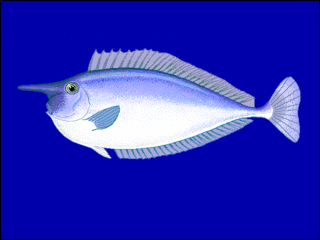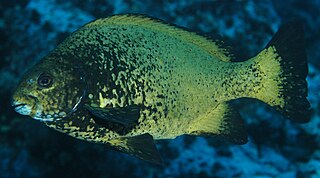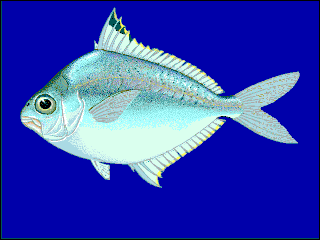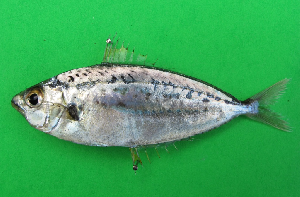
Acanthurus is a genus of marine ray-finned fish belonging to the family Acanthuridae, which includes the surgeonfishes, unicornfishes and tangs, found in the Atlantic, Indian and Pacific Ocean. They are found in tropical oceans, especially near coral reefs, with most species in the Indo-Pacific but a few are found in the Atlantic Ocean. As other members of the family, they have a pair of spines, one on either side of the base of the tail which are dangerously sharp.

Naso is a genus of marine ray-finned fishes belonging to the family, Acanthuridae, the unicornfishes, surgeonfishes and tangs. The fishes in this genus are known commonly as unicornfishes because of the "rostral protuberance", a hornlike extension of the forehead present in some species. Unicorn fish are popular with spearfishermen and may be cooked by grilling them whole. Unicornfish primarily live around coral reefs and eat mostly algae. It is very popular in Maldives.

The sea chubs, also known as rudderfish and pilot fish and in Hawaiian as enenue or nenue, are a family, Kyphosidae, of fishes in the order Perciformes native to the Atlantic, Indian and Pacific Oceans usually close to shore in marine waters.

Leiognathidae, the ponyfishes, slipmouths or slimys / slimies, are a small family of fishes in the order Perciformes. They inhabit marine and brackish waters in the Indian and West Pacific Oceans. They can be used in the preparation of bagoong.

Deveximentum is a genus of ponyfishes native to the Indian Ocean and the western Pacific Ocean.
Deveximentum hanedai is a species of marine ray-finned fish, a ponyfish from the family Leiognathidae. It isnative to the Indian and Pacific ocean waters around the countries of Thailand, Indonesia and Malaysia. It can be found in marine and brackish waters.
Haemulopsis is a genus of marine ray-finned fish, grunts belonging to the family Haemulidae. They are native to the western Atlantic Ocean and, mainly, to the eastern Pacific Ocean.

Eubleekeria is a genus of marine ray-finned fishes, ponyfishes from the family Leiognathidae which are native to the Indian Ocean and the western Pacific Ocean.

Gazza is a genus of marine ray-finned fishes, ponyfishes from the family Leiognathidae which are native to the Indian Ocean and the western Pacific Ocean.

Karalla is a genus of marine ray-finned fishes, ponyfishes from the family Leiognathidae which are native to the Indian Ocean and the western Pacific Ocean.

Leiognathus is a genus of marine ray-finned fishes, ponyfishes from the family Leiognathidae. They are native to the Indian Ocean and the western Pacific Ocean. They are sometimes known as silverbellies.

Nuchequula is a genus of ponyfishes native to the Indian Ocean and the western Pacific Ocean.

Photopectoralis is a genus of marine ray-finned fishes, ponyfish from the family Leiognathidae. They are native to the Indian Ocean and the western Pacific Ocean.

Leiognathus longispinis, commonly known as the longspine- or Smithurst's ponyfish, is a fish of brackish and marine waters found in the Indian and western Pacific Oceans, from India through Malaysia and Indonesia south to northern Australia and east to the Philippines and Fiji It was described in 1835 by French Zoologist Achille Valenciennes from a specimen caught off Waigeo island in Irian Jaya in New Guinea. In 1886 Ramsay and Ogilby described what turned out to the same species from Hood Lagoon in Papua New Guinea, naming it Leiognathus smithursti. In 2008, ichthyologists Prosanta Chakrabarty and John S. Sparks resurrected the genus Aurigequula and placed L. longispinis and L. fasciatus in it, on the basis of a horizontal row of yellow markings on their flanks and elongated second spine of the dorsal fin. However, a molecular study showed that the genus Leiognathus was nested within Aurigequula, and hence the genera were merged once more. Fishbase places this species in Leiognathus while retaining the striped ponyfish in the monotypic Aurigequula.

Photolateralis stercorarius, the oblong slipmouth, is a marine ray-finned fish, a ponyfish from the family Leiognathidae. It has been recorded from Indonesia, Philippines, New Guinea, Guam and Tonga in the western Pacific Ocean. It lives on inner reef flats and in silt-laden inshore waters at depths greater than 20 metres (66 ft). It attains a maximum recorded total length of 10.2 centimetres (4.0 in). It was first formally described in 1907 as known as Leiognathus stercorarius by the American ichthyologists Barton Warren Evermann (1853-1932) and Alvin Seale (1871-1958) with the type locality given as Bulan, Sorsogon in the Philippines. It was more recently named as Equulites stercorarius, but was re-evaluated in 2015 as part of Photolateralis. It is the type species of the genus Photolateralis.

Equulites elongatus, the slender ponyfish, also called the elongate ponyfish, elongate slimy or elongated slipmouth, is a marine fish of the family Leiognathidae native to the western Pacific and Indian Oceans.

Photolateralis is a genus of marine ray-finned fishes, ponyfish from the family Leiognathidae. This genus is unique among ponyfishes in possessing a translucent mid-lateral flank stripe which, depending on the species, may be either a composite stripe of numerous independent translucent windows or a continuous translucent lateral stripe.

Equulites popei, Pope's ponyfish, is a species of marine ray-finned fish, a ponyfish from the family Leiognathidae. It has a wide Indo-Pacific distribution which extends from the Red Sea east to the western Pacific Ocean. It has entered the Mediterranean as a Lessepsian migrant. It was formerly considered to be synonymous with the elongate ponyfish.

Karalla dussumieri, Dussumier's ponyfish, is a species of marine ray-finned fish, a ponyfish from the family Leiognathidae. It is found in the Indo-Pacific region where it occurs from Madagascar and Réunion east to the Philippines. It is found in schools over substrates consisting of coral sand in coastal waters, although it will also enters estuaries. It feeds on small crustaceans, polychaetes, bivalves, foraminiferans, gastropods and nematodes. This species was first formally described as Equula dussumieri in 1835 by Achille Valenciennes with the type locality given as the Coromandel coast. The specific name honours the French voyager and merchant Jean-Jacques Dussumier (1792-1883), who collected the type.
Argentinolycus is a monospecific genus of marine ray-finned fish belonging to the family Zoarcidae, the eelpouts. Its only species is Argentinolycus elongatus which is found in coastal southern eastern South America.
















